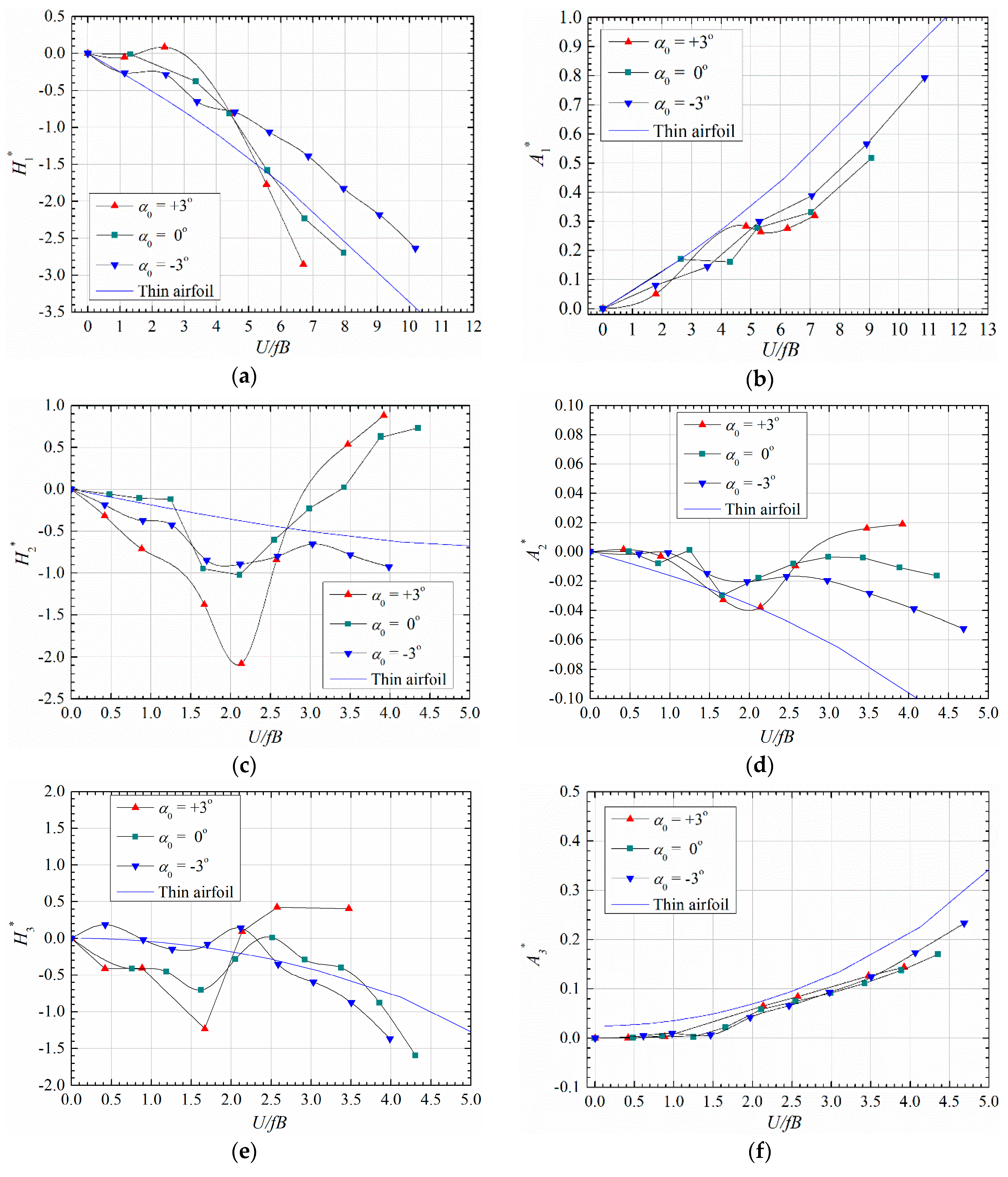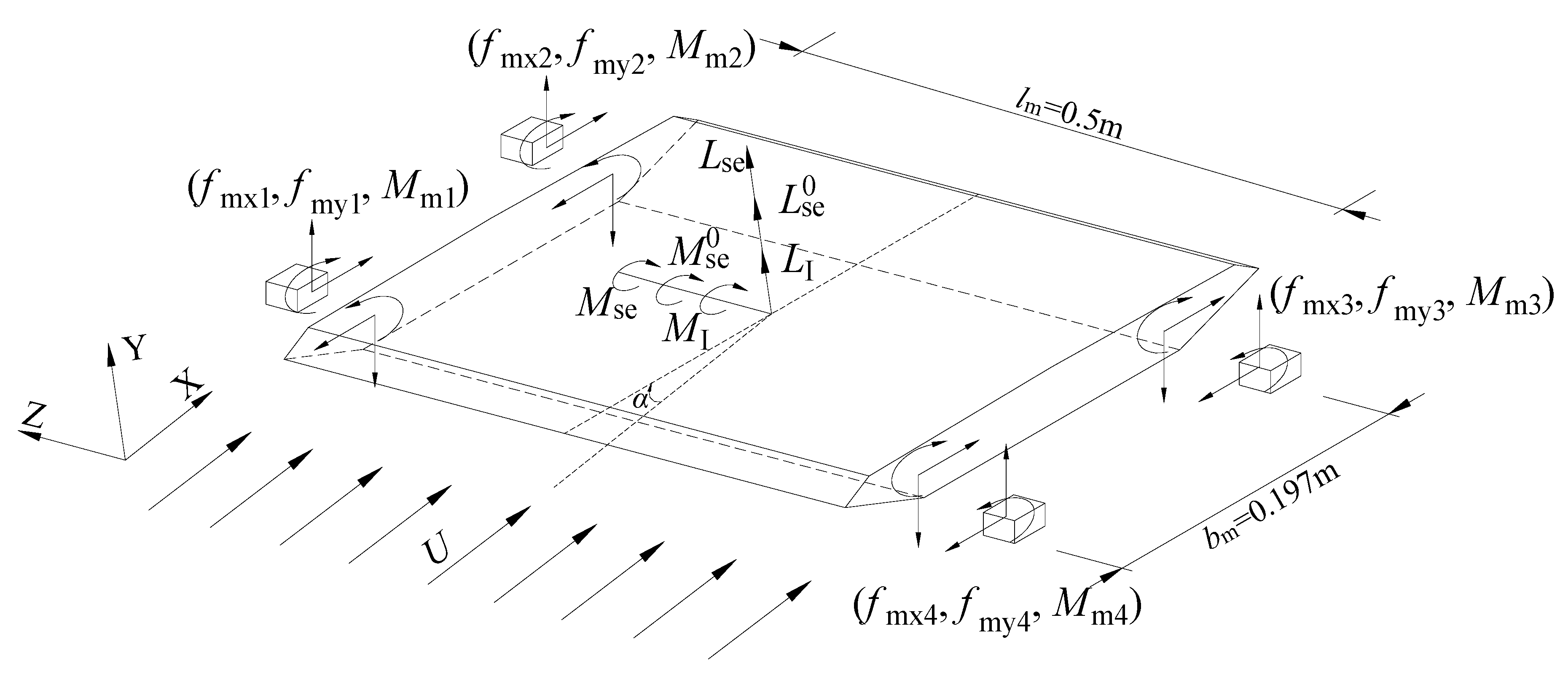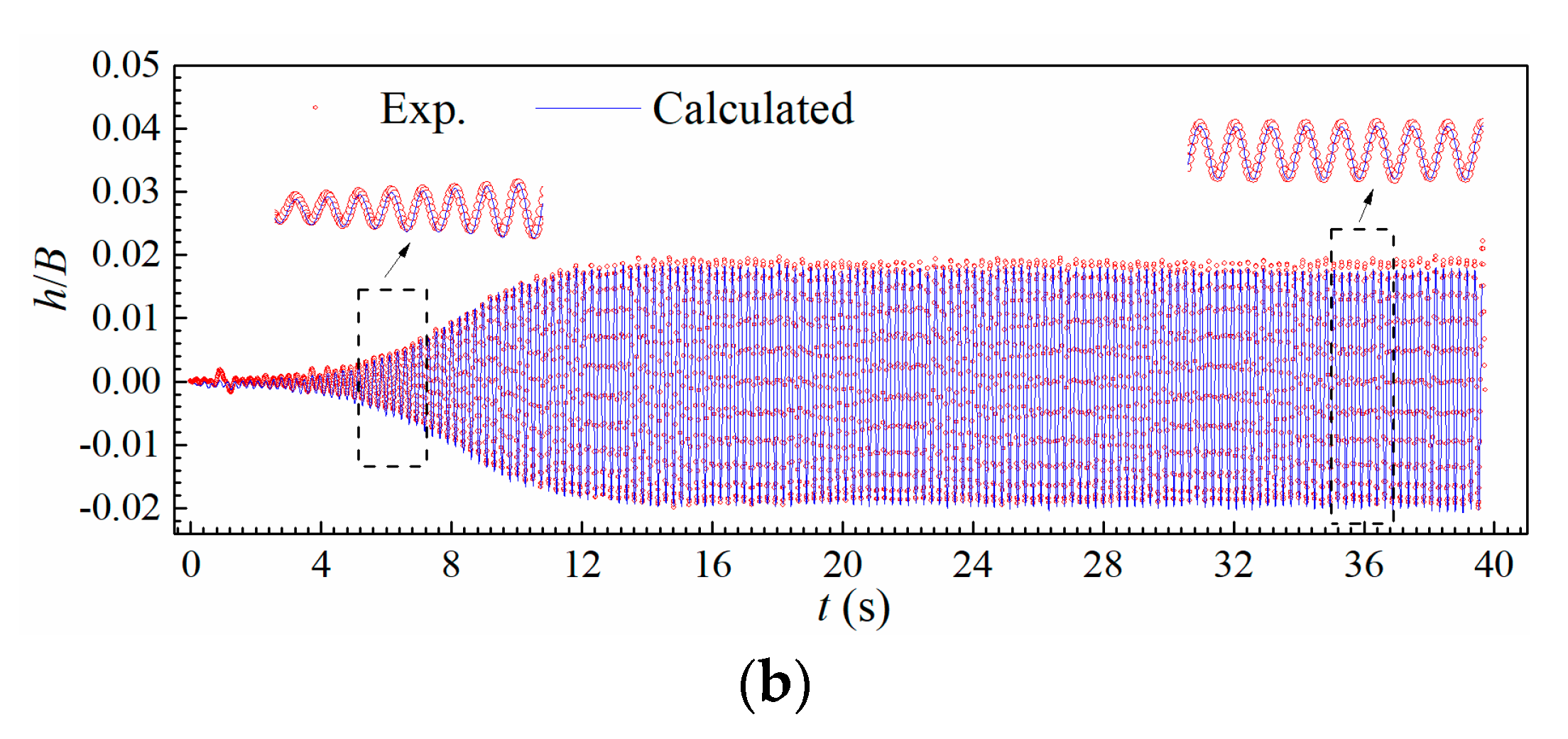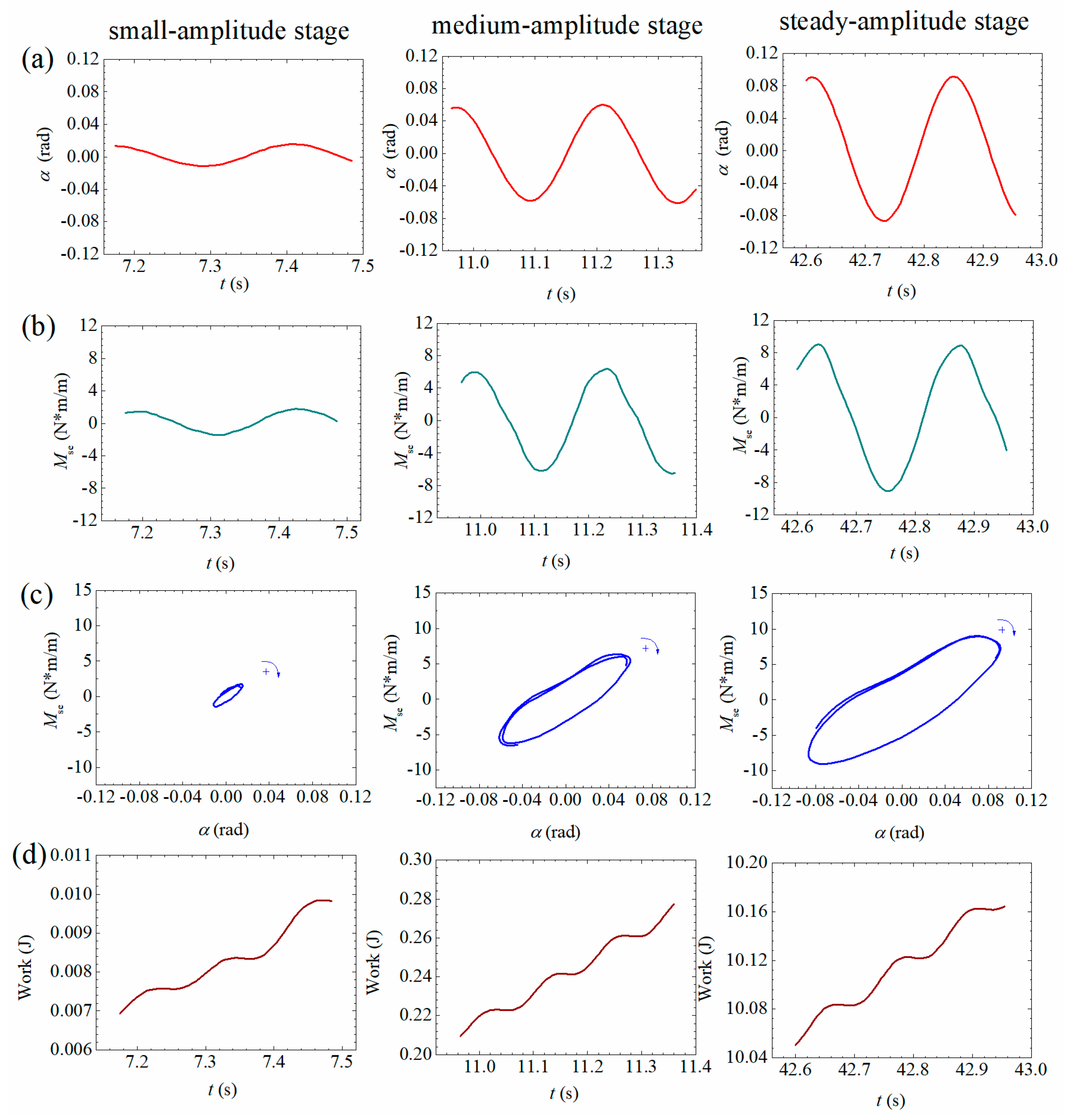Experimental Investigation on the Nonlinear Coupled Flutter Motion of a Typical Flat Closed-Box Bridge Deck
Abstract
:1. Introduction
2. Wind Tunnel Tests
2.1. Experimental Setup
2.2. Linear Aeroelastic Property
2.3. Bifurcation beyond Linear Flutter Boundary
2.4. Vibration Mode during Post-Critical LCO
2.5. Amplitude-Dependent Damping and Frequency
2.6. Coupling of Aerostatic Deformation and Large-Amplitude Vibration
3. Measurement of Nonlinear Aerodynamic Force
3.1. A Novel Measurement Technique
3.2. Aerodynamic Nonlinearity
3.3. Energy Evolving Mechanism
4. Discussion of the Results
5. Conclusions
Author Contributions
Funding
Conflicts of Interest
Notation
| a constant related with initial condition | Reynolds number | ||
| torsional, heaving amplitude | time | ||
| , | flutter derivatives | starting time point | |
| half width of a cross section | torsional period, | ||
| distance of force sensors | wind velocity | ||
| width/depth of a cross section | non-dimensional linear flutter boundary | ||
| , | added damping coefficients | reduced wind velocity, | |
| drag, lift and moment coefficients | , | heaving mode parameters | |
| nth-order derivative of lift coefficient | , | torsional mode parameters | |
| effective windward height | , | normalized mode parameter | |
| distance of spring fixed points | work by self-excited moment | ||
| frequencies in still air | work by self-excited lift | ||
| torsional and heaving frequency | torsional angle, angular velocity and acceleration | ||
| ,, | aerodynamic drag force, lift force and torsional moment per unit length | initial wind angle of attack | |
| heaving displacement, velocity and acceleration | static attack angle under flowing air conditions | ||
| , | pure heaving displacement, heaving static deformation | , | torsional and heaving phase angle |
| , | upper, lower heaving envelopes | heave-torsion coupling ratio | |
| , | heaving, torsional root-mean-squares | mechanical damping ratios in still air | |
| height of wind-tunnel test section | torsional damping ratio | ||
| turbulence intensity | total damping ratio of the torsional mode | ||
| effective mass moment of inertia | amplitude-dependent structural damping ratio | ||
| , | elastic heaving, torsional stiffness | aerodynamic damping ratio induced by self-excited force | |
| reduced frequency | air density | ||
| length of middle ‘coat’ segment | torsional phase angle | ||
| axial length of a sectional model | circular frequency of torsional mode | ||
| inertial lift per unit length, | , | torsional, heaving circular frequencies in still air | |
| self-excited lift and torsional moment | total drift of the heaving zero position | ||
| effective mass per unit length | heaving deformation under small amplitude | ||
| , | added mass, mass moment of inertia | heaving deformation under large amplitude | |
| , | mass, moment of inertia of middle ‘coat’ | effective attack angle induced vibration | |
| inertial moment per unit length | drift of static attack angle relative | ||
| , | resultant torsional moment and lift | phase difference between heaving and torsional displacement | |
| , | measured force signals | vector of torsional mode | |
| , | non-wind-induced force per unit length | the real part of a complex value |
References
- Scanlan, R.H.; Tomko, J.J. Airfoil and bridge deck flutter derivatives. J. Eng. Mech. ASCE 1971, 97, 1717–1737. [Google Scholar]
- Zhu, L.D.; Gao, G.Z. Influential factors of soft flutter phenomenon for typical bridge deck sections. J. Tongji Univ. Nat. Sci. 2015, 43, 1289–1294, 1382. (In Chinese) [Google Scholar]
- Matsumoto, M.; Shirato, H.; Hirai, S. Torsional flutter mechanism of 2-D H-shaped cylinders and effect of flow turbulence. J. Wind Eng. Ind. Aerodyn. 1992, 41–44, 687–698. [Google Scholar] [CrossRef]
- Daito, Y.; Matsumoto, M.; Araki, K. Torsional flutter mechanism of two-edge girders for long-span cable-stayed bridge. J. Wind Eng. Ind. Aerodyn. 2002, 90, 2127–2141. [Google Scholar] [CrossRef]
- Zheng, S.X.; Guo, J.F.; Zhu, J.B.; Tang, Y. Characteristics and suppression neasures for soft flutter of main girder with Π-shaped cross section. J. Southwest Jiaotong Univ. 2017, 52, 458–465. [Google Scholar]
- Tang, Y.; Hua, X.G.; Chen, Z.Q.; Zhou, Y. Experimental investigation of flutter characteristics of shallow Π section at post-critical regime. J. Fluids Struct. 2019, 88, 275–291. [Google Scholar] [CrossRef]
- Gao, G.Z.; Zhu, L.D.; Han, W.S.; Li, J.W. Nonlinear post-flutter behavior and self-excited force model of a twin-side-girder bridge deck. J. Wind Eng. Ind. Aerodyn. 2018, 177, 227–241. [Google Scholar] [CrossRef]
- Amandolese, A.; Michelin, S.; Choquel, M. Low speed flutter and limit cycle oscillations of a two-degree-of-freedom flat plate in a wind tunnel. J. Fluids Struct. 2013, 43, 244–255. [Google Scholar] [CrossRef] [Green Version]
- Pigolotti, L.; Mannini, C.; Bartoli, G. Experimental study on the flutter-induced motion of two-degree-of-freedom plates. J. Fluids Struct. 2017, 75, 77–98. [Google Scholar] [CrossRef]
- Náprstek, J.; Pospíšil, S.; Hračov, S. Analytical and experimental modeling of non-linear aeroelastic effects on prismatic bodies. J. Wind Eng. Ind. Aerodyn. 2007, 95, 1315–1328. [Google Scholar] [CrossRef]
- Ying, X.Y.; Xu, F.Y.; Zhang, M.J.; Zhang, Z. Numerical explorations of the limit cycle flutter characteristics of a bridge deck. J. Wind Eng. Ind. Aerodyn. 2017, 169, 30–38. [Google Scholar] [CrossRef]
- Gao, G.Z.; Zhu, L.D.; Wu, H.; Li, J.W. Aerodynamic nonlinearities of coupled soft flutter of a flat closed-box bridge deck. China J. Highw. Transp. 2019, 32, 125–134. (In Chinese) [Google Scholar]
- Wu, B.; Chen, X.Z.; Wang, Q.; Liao, H.L.; Dong, J.H. Characterization of vibration amplitude of nonlinear bridge flutter from sectional model test to full bridge estimation. J. Wind Eng. Ind. Aerodyn. 2020, 197, 104048. [Google Scholar] [CrossRef]
- Zhang, M.J.; Xu, F.Y.; Zhang, Z.B.; Ying, X.Y. Energy budget analysis and engineering modeling of post-flutter limit cycle oscillation of a bridge deck. J. Wind Eng. Ind. Aerodyn. 2019, 188, 410–420. [Google Scholar] [CrossRef]
- Gao, G.Z.; Zhu, L.D. Nonlinearity of mechanical damping and stiffness of a spring-suspended sectional model system for wind tunnel tests. J. Sound Vib. 2015, 355, 369–391. [Google Scholar] [CrossRef]
- Ding, Q.S.; Wang, J.; Zhu, L.D. Coupled free vibration technique for identifying flutter derivatives of bridge decks. J. Vib. Shock 2012, 31, 5–8, 25. (In Chinese) [Google Scholar]
- Theodorsen, T. General Theory of Aerodynamic Instability and the Mechanism of Flutter; NACA Technical Report 496; U.S. National Advisory Committee for Aeronautics: Langley, VA, USA, 1949.
- Zhu, L.D.; Guo, Z.S. Wind Tunnel Study on Wind-Resistant Performance of Ningbo Xiangshan Harbor Bridge in Preliminary Design Stage; State Key Laboratory for Disaster Reduction in Civil Engineering: Shanghai, China, 2007; p. 164. (In Chinese) [Google Scholar]
- Wilkinson, R.H. Fluctuating pressures on an oscillating square prism part I: Chordwise distribution of fluctuating pressure. Aeronaut. Q. 1981, 32, 97–110. [Google Scholar] [CrossRef]
- Gao, G.Z.; Zhu, L.D. Measurement and verification of unsteady galloping force on a rectangular 2:1 cylinder. J. Wind Eng. Ind. Aerodyn. 2016, 157, 76–94. [Google Scholar] [CrossRef]
- Diana, G.; Rocchi, D.; Argentini, T.; Muggiasca, S. Aerodynamic instability of a bridge deck section model: Linear and nonlinear approach to force modeling. J. Wind Eng. Ind. Aerodyn. 2010, 98, 363–374. [Google Scholar] [CrossRef]
- Zhang, Z.T.; Ge, Y.J.; Yang, Y.X. Torsional stiffness degradation and aerostatic divergence of suspension bridge decks. J. Fluids Struct. 2013, 40, 269–283. [Google Scholar] [CrossRef]


























| #. | α0 | ξα0 | ξh0 | ft0 | fh0 | Jm | m |
|---|---|---|---|---|---|---|---|
| (°) | (%) | (%) | (Hz) | (Hz) | (kg·m2/m) | (kg/m) | |
| A1 | 3 | 0.117 | 0.325 | 4.834 | 1.773 | 0.136 | 5.774 |
| A2 | 3 | 0.178 | 0.490 | 4.827 | 1.789 | 0.139 | 5.774 |
| B1 | 0 | 0.101 | 0.343 | 4.836 | 1.773 | 0.136 | 5.774 |
| B2 | 0 | 0.209 | 0.521 | 4.822 | 1.788 | 0.138 | 5.774 |
| C1 | −3 | 0.0930 | 0.566 | 4.820 | 1.774 | 0.136 | 5.774 |
| C2 | −3 | 0.197 | 0.818 | 4.825 | 1.789 | 0.139 | 5.774 |
© 2020 by the authors. Licensee MDPI, Basel, Switzerland. This article is an open access article distributed under the terms and conditions of the Creative Commons Attribution (CC BY) license (http://creativecommons.org/licenses/by/4.0/).
Share and Cite
Gao, G.; Zhu, L.; Wang, F.; Bai, H.; Hao, J. Experimental Investigation on the Nonlinear Coupled Flutter Motion of a Typical Flat Closed-Box Bridge Deck. Sensors 2020, 20, 568. https://doi.org/10.3390/s20020568
Gao G, Zhu L, Wang F, Bai H, Hao J. Experimental Investigation on the Nonlinear Coupled Flutter Motion of a Typical Flat Closed-Box Bridge Deck. Sensors. 2020; 20(2):568. https://doi.org/10.3390/s20020568
Chicago/Turabian StyleGao, Guangzhong, Ledong Zhu, Feng Wang, Hua Bai, and Jianming Hao. 2020. "Experimental Investigation on the Nonlinear Coupled Flutter Motion of a Typical Flat Closed-Box Bridge Deck" Sensors 20, no. 2: 568. https://doi.org/10.3390/s20020568





